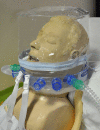Non-invasive ventilation in cardiogenic pulmonary edema
- PMID: 30370282
- PMCID: PMC6186545
- DOI: 10.21037/atm.2018.04.39
Non-invasive ventilation in cardiogenic pulmonary edema
Abstract
Cardiogenic pulmonary edema (CPE) is among the most common causes of acute respiratory failure (ARF) in the acute care setting and often requires ventilatory assistance. In patients with ARF due to CPE, use of non-invasive positive airway pressure can decrease the systemic venous return and the left ventricular (LV) afterload, thus reducing LV filling pressure and limiting pulmonary edema. In these patients, either non-invasive ventilation (NIV) or continuous positive airway pressure (CPAP) can improve vital signs and physiological parameters, decreasing the need for endotracheal intubation (ETI) and hospital mortality when compared to conventional oxygen therapy. Results on the use of NIV or CPAP in patients with CPE prior to hospitalization are not homogeneous among studies, hampering any conclusive recommendation regarding their role in the pre-hospital setting.
Keywords: Heart failure, pulmonary edema; continuous positive airway pressure (CPAP); non-invasive ventilation (NIV).
Conflict of interest statement
Conflicts of Interest: The authors have no conflicts of interest to declare.
Figures
Similar articles
-
ISCCM Guidelines for the Use of Non-invasive Ventilation in Acute Respiratory Failure in Adult ICUs.Indian J Crit Care Med. 2020 Jan;24(Suppl 1):S61-S81. doi: 10.5005/jp-journals-10071-G23186. Indian J Crit Care Med. 2020. PMID: 32205957 Free PMC article.
-
Non-Invasive Mechanical Ventilation Versus Continuous Positive Airway Pressure Relating to Cardiogenic Pulmonary Edema in an Intensive Care Unit.Arch Bronconeumol. 2017 Oct;53(10):561-567. doi: 10.1016/j.arbres.2017.02.005. Epub 2017 Jul 8. Arch Bronconeumol. 2017. PMID: 28689679 Clinical Trial. English, Spanish.
-
Noninvasive ventilation in patients with acute cardiogenic pulmonary edema.Respir Care. 2009 Feb;54(2):186-95; discussion 195-7. Respir Care. 2009. PMID: 19173751
-
The use of non-invasive ventilation in the treatment of acute cardiogenic pulmonary edema.Eur Rev Med Pharmacol Sci. 2007 May-Jun;11(3):193-205. Eur Rev Med Pharmacol Sci. 2007. PMID: 17970236 Review.
-
Non-invasive Positive Pressure Ventilation for Acute Cardiogenic Pulmonary Edema and Chronic Obstructive Pulmonary Disease in Prehospital and Emergency Settings.Cureus. 2021 Jun 13;13(6):e15624. doi: 10.7759/cureus.15624. eCollection 2021 Jun. Cureus. 2021. PMID: 34277241 Free PMC article. Review.
Cited by
-
Efficacy of Non-Invasive Ventilation in Acute Coronary Syndrome Patients with Acute Systolic Heart Failure.Rev Cardiovasc Med. 2022 Sep 5;23(9):294. doi: 10.31083/j.rcm2309294. eCollection 2022 Sep. Rev Cardiovasc Med. 2022. PMID: 39077698 Free PMC article.
-
Potential rebreathing of carbon dioxide during noninvasive ventilation provided by critical care ventilator.Can J Respir Ther. 2022 Jul 27;58:111-114. doi: 10.29390/cjrt-2022-013. eCollection 2022. Can J Respir Ther. 2022. PMID: 35950170 Free PMC article.
-
Prevalence and Economic Impact of Acute Respiratory Failure in the Prehospital Emergency Medical Service of the Madrid Community: Retrospective Cohort Study.JMIR Public Health Surveill. 2025 Jan 16;11:e66179. doi: 10.2196/66179. JMIR Public Health Surveill. 2025. PMID: 39819841 Free PMC article.
-
Dexmedetomidine Improves Cardiovascular and Ventilatory Outcomes in Critically Ill Patients: Basic and Clinical Approaches.Front Pharmacol. 2020 Feb 28;10:1641. doi: 10.3389/fphar.2019.01641. eCollection 2019. Front Pharmacol. 2020. PMID: 32184718 Free PMC article. Review.
-
Non-Invasive Ventilatory Support In the Elderly.Curr Geriatr Rep. 2019 Sep;8(3):153-159. doi: 10.1007/s13670-019-00287-5. Epub 2019 Jun 13. Curr Geriatr Rep. 2019. PMID: 32509503 Free PMC article.
References
Publication types
LinkOut - more resources
Full Text Sources
Research Materials
Miscellaneous




